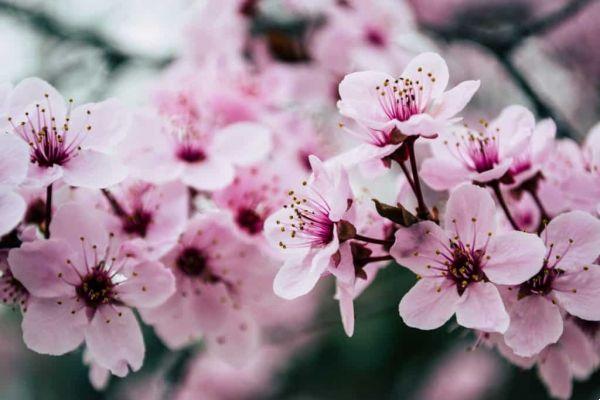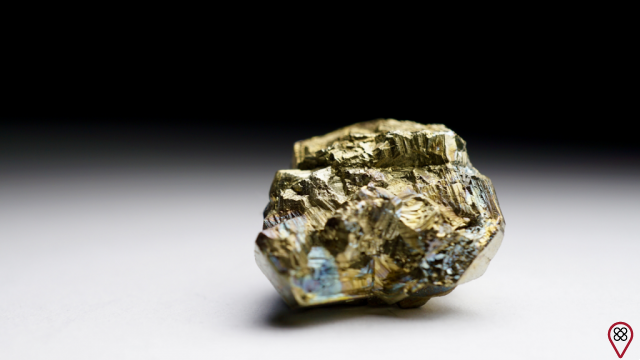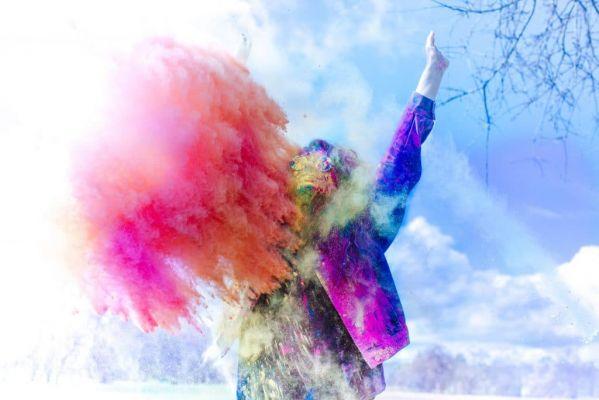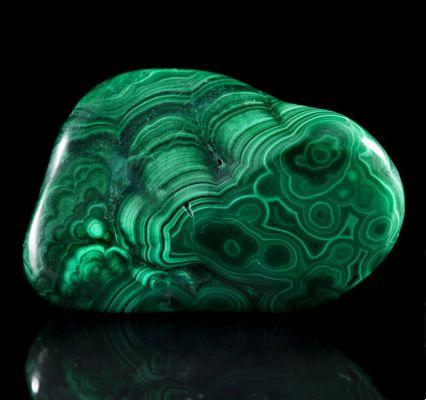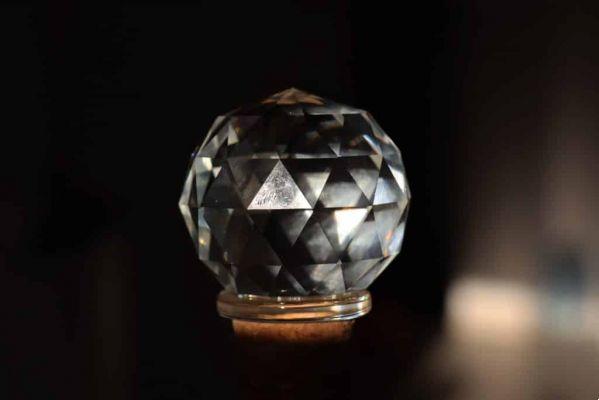Birds have fascinated humanity since ancient times, whether for their song, their plumage, their ability to fly, to organize themselves into flocks and communities, to protect themselves or to beautify the most varied landscapes that our eyes can contemplate. In different sizes, like the ostrich and the hummingbird, some can fly, others are excellent swimmers and others are terrestrial and excellent runners.
In this article, you will get to know the peacock, one of the most appreciated land birds, mainly for the beauty of its plumage, used as an adornment in accessories, clothing and costumes, among other applications. Exotic, this bird belongs to the pheasant family, and there are three important species: the blue or Indian peacock, originally from South Asia; the green or Javanese peacock, from southwest Asia; and the Congo peacock, found in Central Africa. Only the males of the blue and green species have a tail with colored feathers.
Despite being adapted to captivity for thousands of years, the peacock, when in its natural habitat, is found in lowland forests, and at night it sleeps on the trees. The males of the blue and green species can measure from 90 to 130 centimeters; and the females are almost the same size – in both species, they are green and brown. The male's tail has feathers about 1,5 meters long, in a metallic green color. On each is a brighter point, similar to an eye. Both males and females have a crown of feathers on their heads.
What stands out the most is the fact that the peacock displays its tail feathers, which it lifts and opens in a fan shape, to attract the female or to appear larger in the face of a threat. Similarly, the peacock's body is blue and green, but the tail is small and rounded. The peacock (female peacock) has green and brownish tones.
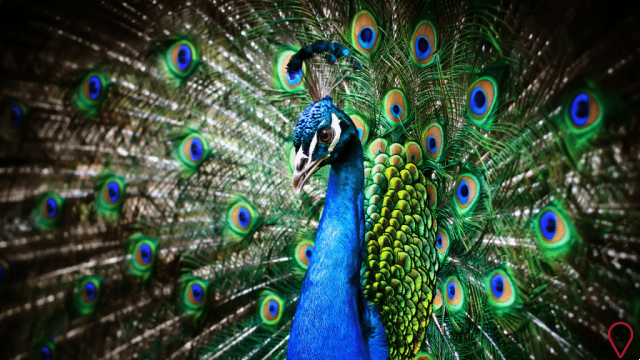
A curious fact is that the white peacock, quite rare, is actually the partially albino blue peacock, differing from the others due to the absence of melanin in almost its entirety. This condition makes it sensitive to sunlight and susceptible to predators if it is in its natural habitat.
Although the curiosities about peacocks are many, there is a special, mystical and sacred meaning around the world attributed to them. And that is the main approach of this article. So take a few minutes of your time reading the following text and learn more about the peacock symbolism!
What does the peacock represent?
For the collective unconscious, the peacock represents beauty, grace, love, personal power, pride, self-esteem, lightness, exuberance, prosperity and royalty. Even when it is said that someone is strutting, the idea is that the person is showing off, showing ostentation, vanity, arrogance or magnitude. The interpretations can be positive or negative, however they refer to self-esteem.
In addition, even though this bird is majestic and beautiful, its feet do not have the same splendor, being even disconnected from the beauty of the plumage, which symbolizes the duality that human beings experience throughout their journey: light and shadow, beautiful and ugly, and so many other oppositions, making it clear that balance is essential in life.
Still in the spiritual sense, this archetype refers to transformation, psychic healing, inner peace, courage to eliminate fears and the ability to regenerate, mainly because the peacock feathers fall every year in winter, and new ones are born in spring. It is the meaning of resurgence, of renewal, of success over death.
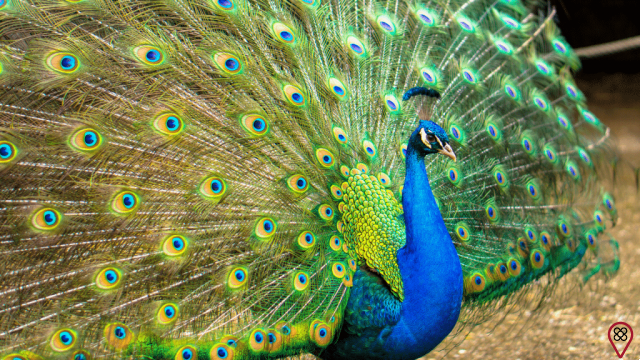
The open tail of a peacock resembles the shape of the rising sun, the celestial vault and the “eye” of each feather resembles the stars of the Cosmos. Thus, the symbolism of the peacock is so strong that many people tattoo this bird on their skin, in a real way, stylized or reduced to a feather, to always have it with them and remember its meaning, especially its transmutation capacity.
However, it is the spiritual meaning attributed to the peacock that lasts for millennia, especially in eastern cultures and in relation to major religions. Considered the bird of the gates of paradise, he represents protection, good luck, intelligence, wisdom, compassion, purification, prosperity and fertility.
The peacock for different philosophies
The way of thinking, values and beliefs of a people are widely studied by areas of human knowledge, such as Philosophy, Anthropology, Sociology, among others. All seek to understand life on the face of the Earth, both in the present moment and in the past, and also to identify future possibilities. In this sense, symbols are significant referential instruments, as they portray ideology over time. Thus, the peacock has been showing itself in different philosophies. Follow up!
Ancient Greece
The peacock was a symbol in Greek mythology. It was one of the animals of the goddess Hera (Juno, for the Romans), ruler of the marriage union. It is said that her husband, Zeus, who was not very faithful, went to meet a nymph named Lo. Hera, however, very intuitive, followed him and, seeing the fact, transformed the nymph into a heifer. She even asked Zeus to present her with the young cow. To avoid suspicion, he granted the request. So Hera asked Argos, her faithful servant and a giant with a hundred eyes, to watch over the heifer at all times. Even sleeping with 50 eyes, he watched her with the other half and kept her isolated. However, Zeus discovered the fact and tasked Hermes with freeing Lo. Playing a tune, Hermes made Argos close all his eyes and fall asleep completely, and rescued the girl. But he ended up killing Argos while he slept. When Hera found out, she was devastated at the loss of her servant and, to immortalize him, she collected all one hundred eyes and placed them in the tail of her sacred peacock. Although with a cause linked to jealousy, the symbol denotes vigilance, eternity and regeneration.
Christianity
Among Christians, depending on the pattern of the peacock's tail feathers, the meaning of omniscience (God, who sees all and knows all) is attributed. The fan formed by the open tail represents the Universe.
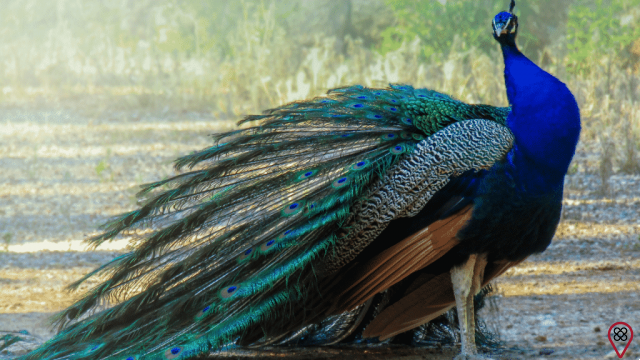
In addition, the “eyes” of the feathers also symbolize the stars. Fan and eyes together represent eternity, immortality and wholeness, being the omnipresence of God. The crown (crest), similar to a six-pointed star, represents the majesty and power, that is, the omnipotence of God.
Budismo
In Buddhism, the peacock is related to spiritual evolution. The “eyes” on the bird's feathers symbolize vigilance; the tail, when it is open, represents accessibility to achieve purity. The peacock is a symbol of wisdom and, in ancient sculptures of Buddha, he is represented as the bird. Furthermore, some Buddhist legends relate that he was a golden peacock in past lives and that the Buddha Amitabha (Buddha of Eternal Light) has his throne under a tree, supported by eight peacocks.
In Tibetan Buddhism, the figure of the peacock is present in religious ceremonies, symbolizing the bodhisattva (the one who transcends), who is not attracted by emotional poisons - such as jealousy, envy, anger and anger - nor is he contaminated by emotions. impure aspects. He is able to get along with people to help them achieve enlightenment. It symbolizes good omen, purity and purification of the soul. Already in the Buddhism of China and Japan, the peacock is associated with the goddess of compassion and mercy Kannon Bosatsu or Kuan Yin.
Hinduism
Although the peacock feeds on insects, seeds, leaves, flower petals and small invertebrates, it can also consume lizards and snakes. Thus, the symbolism of the peacock in Hinduism is related to immortality, because the bird absorbs the poison and stays alive. In addition, it still transforms something negative into positive, suffering into beauty, evil into good.
Still, the peacock is represented as the bird of the god Krishna, which uses one of the feathers on its head, as a domain of vanity for enlightenment and consciousness. Likewise, Saraswati – the goddess of music, poetry, knowledge, wisdom and studies – is sometimes seen riding a peacock. Similarly, the peacock's feathers represent the qualities of patience, prosperity, kindness and good luck of the goddess Lakshmi.
Furthermore, in India, the bird is so venerated that in the gardens of palaces, Hindu temples and holy places, it is cared for and fed by priests. Since 1963 it has been the country's symbol bird. It is also associated with the Peacock Throne, one of the most important objects in Indian history. All studded with emeralds, diamonds, rubies, sapphires and pearls, the throne was taken as a war trophy by the Persian king Nadir Shah in 1739 and never found again.
Traditional Chinese Religion and Syncretisms
Among the Taoists, Confucians and Buddhists of China, the peacock represents the manifestation of the Celestial Phoenix on Earth, one of the Twelve Symbols of Sovereignty. The “eyes” on its tail attract luck and success. They bring positive energy and enable public admiration. In addition, it is believed that the peacock's grandeur can rekindle the flame of a love relationship.
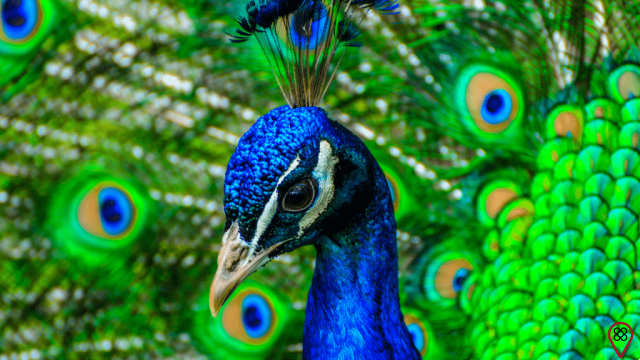
In the Ming dynasty, the peacock symbolism was related to the divine, holiness, order, power, beauty and protection. Even in China and Vietnam, from the XNUMXth to the XNUMXth century, the bird became a symbol of abundance, prosperity and fertility. The Chinese believed that the peacock's gaze was even capable of impregnating a woman.
Islamism
In Islam, the peacock is seen as the one who welcomes souls at the gates of paradise. He is a symbol of the vision of God, for he is the animal with the "hundred eyes". Furthermore, in the esoteric branch of Islam, known as the Sufi tradition, the open-tailed peacock represents the image of the Higher Self seen reflected in a mirror at the moment when Light was made in the Universe, symbolizing the spiritual virtues emanating from the Eye of the Heart.
shamanism
For shamanism, the symbolism of the peacock is related to kindness, magic and generosity, as the bird has an ascending wisdom, being able to use energy to create anything it wants. In fact, the Peacock Clan, in ancestral shamanism, glorifies the bird and its ruling element, fire.
The peacock is an animal that can be invoked for psychic healing, in the sense of providing attitudes of courage and allaying fears. An ancient shaman order known as the Order of the White Peacock is also believed to have descended from the planet Venus. So this bird is seen as a protective being, the one who guards the temple of that order on that planet and screams to warn when someone approaches.
Theosophy
In theosophy, a spiritualist doctrine related to the occult tradition and oriental religions founded by Helena Blavatsky (1831-1891) in the XNUMXth century, the peacock is an icon of initiation and the intelligence of a hundred eyes. It symbolizes wisdom and hidden knowledge. The "eyes" of this bird's feathers are associated with the pineal gland and represent extrasensory abilities, the sixth sense, intuition, clairvoyance and mediumship.
The Sufi Myth of the Peacock
Peacock symbolism is also present in Sufi myth. According to the story, there was a boy named Adi, who wanted to acquire more knowledge about the world, so a teacher he had suggested that Adi go south, corresponding to Iraq, and learn the meaning of the peacock and the snake.
In the country, Adi met the two animals and talked to each of them. He wanted to know what the peacock and snake accomplished to understand what made them so important. First, the peacock said that it was the most important animal, because it symbolized being, aspiration, heavenly beauty and divine knowledge, hidden from human beings.

Afterwards, the snake stated that it also represented everything the peacock had said, but it symbolized all these characteristics being on the earth, reminding the human being that he is part of that place. Trying to appear more important, the peacock said that the snake was sneaky and dangerous and couldn't be better than him.
The snake's cunning, however, made her say that the peacock also has flaws, such as vanity and ostentation, in addition to being a weird animal. In the midst of this discussion, Adi, who was listening intently, declared that there was no animal more important between the two, and that both the peacock and the snake held lessons for humanity.
The lesson brought by the snake is that, even though it can rise, it continues to crawl, just like humans, in a symbolic way. The peacock, on the other hand, cannot ascend, because it is very vain, like so many people, that is, both represent the potentials that human beings have, but that they could not reach for some reason, so they carry a message of wisdom.
white peacock symbolism
As we said at the beginning, the white peacock is rare, being an albino bird. More fragile than the others in relation to sunlight and predators, due to the lack of pigmentation in the feathers, it symbolizes neutrality, purity, peace and generosity.
Considered a symbol of death, resurrection and longevity of life, mainly associated with Jesus Christ, it means spiritual elevation and connection with the divine. Furthermore, it symbolizes the royalty and purity of the heart of Jesus Christ. The color also represents the Holy Spirit.
How to use the peacock symbolism in daily life?
Eventually we all need to transform dense energies into higher energies to achieve serenity and peace of mind. Also, in the face of difficulties, we need to reinforce self-esteem and make suffering a learning experience, finding beauty in this experience. To do so, we can admire a peacock figure, whether in a painting, in a book, on a computer screen background, on clothing or in an image on the cell phone. A few minutes a day are enough to rescue the archetypes he represents and get the energy you want.
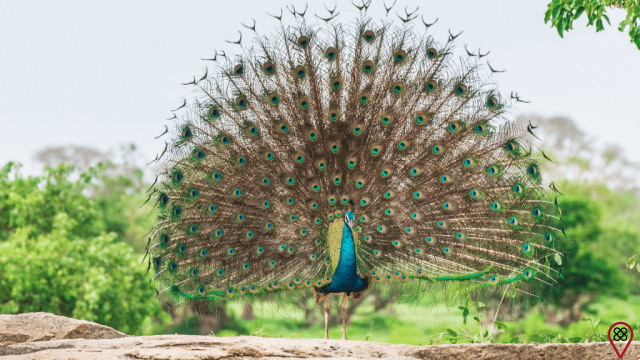
Peacock energy at home
Have you ever thought about putting the image of a peacock in your house? It can be on a statue, on a painting, on a pillow or even on the colors of some part of the decoration. A simple representation of this bird will already attract the good energy that the peacock presents.
This energy is that of spiritual greatness. The peacock is a symbol of the soul, peace, beauty, prosperity, love and compassion, making those close to him evolve in the face of life's difficulties. This figure, represented in your home, can stimulate affection, dialogue and overcoming, in addition to bringing luck.
Also, the peacock is a symbol of courage, because he is not afraid to expand his own tail and shine to the world, showing who he really is. At the same time, the changing of the peacock's feathers indicates that we need to renew our energies and leave behind what hinders our evolution.
A peacock in your home, represented however you wish, is therefore a very positive sign. It will help you see the bright side of life and who you are, giving you the light you need to act authentically, to get along well with others, and to keep your home in good vibes.
The peacock's vision of preservation
There is a belief that finding a peacock feather brings good luck, peace of mind and serenity. However, not even going to the zoo in winter is possible to find a feather of this bird. This plumage is extremely coveted, as are some other birds, such as the pheasant and the macaw.
In Spain, due to the samba school parades during Carnival, for the making of the muses' costumes and the highlights of floats, many peacock feathers are used every year, making the country a major importer of this material, which comes from countries like India, China and South Africa. It is important to note that the feathers are pulled from the animal, in a very cruel and painful process.
You may also like
- Understand how Reiki works in animals and be surprised
- See what your spirit animal is and what it means
- Get excited about the protection animals bring us
The peacock also represents a true paradox, because, since its symbolism highlights kindness, mercy, transformation and spiritual elevation, subjecting such a splendorous bird to such a practice seems like an inconsistency. In addition, the industry already presents, for carnival purposes, synthetic materials, very similar to natural ones. And many schools – the most conscientious – are already making this substitution.
So, to finish, enjoy the symbolism of the peacock and the lessons of generosity and spirituality that it has been teaching for thousands of years and open your mind, expand your consciousness and become an agent of paradigm shifts. Do good for yourself and for others, regardless of the species they belong to. Preserve nature, beauty and life! Transcend!




